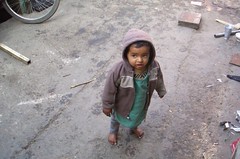 As we were travelling last week across Delhi to show our the planet why land to some friends our vehicle often stopped courtesy the mind boggling traffic jam that Delhi is experiencing these days with the construction frenzy that seems to have taken over our city.
As we were travelling last week across Delhi to show our the planet why land to some friends our vehicle often stopped courtesy the mind boggling traffic jam that Delhi is experiencing these days with the construction frenzy that seems to have taken over our city.
At many of these stops the children of constructions workers waived at us with broad smiles and innocent faces. These kids live in the tiny tents pitched around the sites. They are often brought from far away states by exploitative contractors who find these new migrants easier to manipulate than the local ones. They live under abysmal conditions and barely get enough to eat. Their children never go to school. The average of children in these families is 4 and soon they join the ranks of child labour so rampant in our shining capital city.
Each of these kids will be left without education and will follow the pattern of their parents: early marriage and multiple children who will in turn remain illiterate and so on. It is not difficult to imagine the multiplier effect on the population of India.
According to the HRD Ministry’s own figures, almost 90 per cent of India’s children drop out of school and never even make it to higher education. In the light of this the situation starts looking apocalyptic and India will remain the country with the largest numbers of illiterate in the world.
All education policies have failed and the state of government run schools is deplorable. While political honchos are busy redefining creamy layers of so called backward communities, children are simply dropping out. One of the so called solutions often proffered is to privatise education. This is absurd in a land where the Constitution guarantees free education and compulsory education to all children between the age of 6 and 14. (86th amendment).
The plight of India’s children is lamentable. Here are some facts from the 7th All India Education Survey, 2002
- Less than half of India’s children between the age 6 and 14 go to school.
- A little over one-third of all children who enroll in grade one reach grade eight.
- At least 35 million children aged 6 – 14 years do not attend school.
- 53% of girls in the age group of 5 to 9 years are illiterate.
- In India, only 53% of habitation has a primary school.
- In India, only 20% of habitation has a secondary school.
- On an average an upper primary school is 3 km away in 22% of areas under habitations.
- In nearly 60% of schools, there are less than two teachers to teach Classes I to V.
- On an average, there are less than three teachers per primary school. They have to manage classes from I to V every day.
- High cost of private education and need to work to support their families and little interest in studies are the reasons given by 3 in every four drop-outs as the reason they leave.
- Dropout rates increase alarmingly in class III to V, its 50% for boys, 58% for girls.
- 1 in 40, primary school in India is conducted in open spaces or tents.
- More than 50 per cent of girls fail to enroll in school; those that do are likely to drop out by the age of 12. 50% of Indian children aged 6-18 do not go to school.
Think about it.





completely agree with you..private schools will eliminate whatever chance these kids have of getting an education..
…you are doing an awesome work…..hats off to you….I would love to contribute in your endeavours